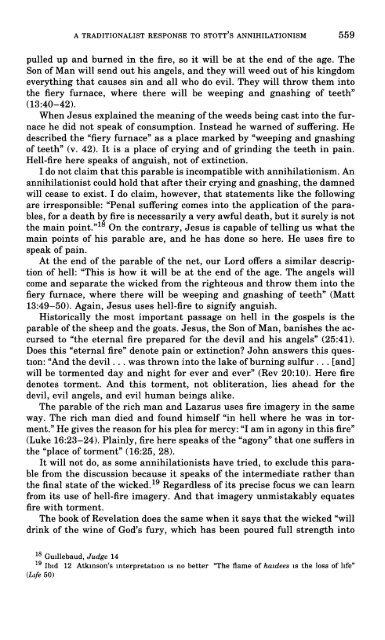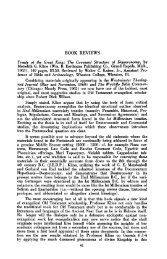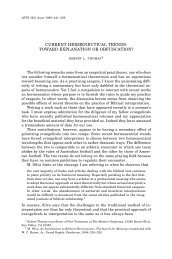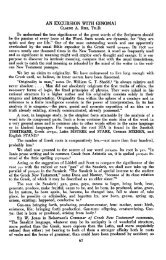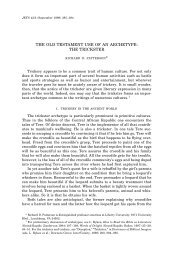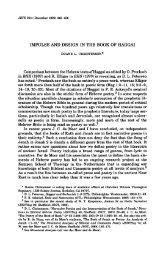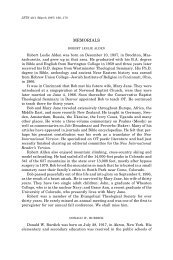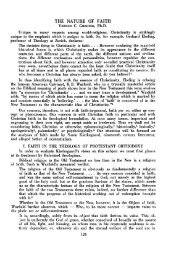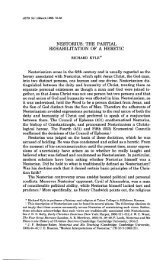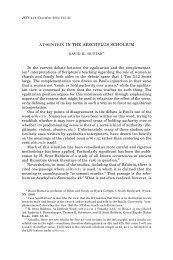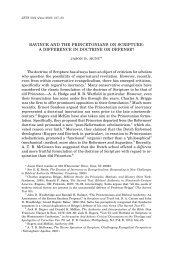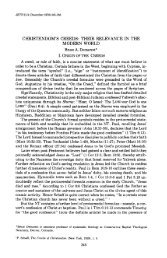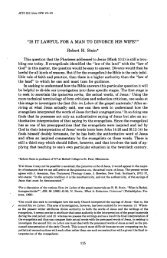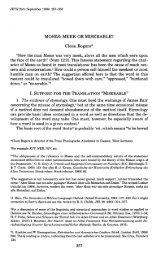a traditionalist response to john stott's arguments for annihilationism
a traditionalist response to john stott's arguments for annihilationism
a traditionalist response to john stott's arguments for annihilationism
Create successful ePaper yourself
Turn your PDF publications into a flip-book with our unique Google optimized e-Paper software.
A TRADITIONALIST RESPONSE TO STOTT'S ANNIHILATIONISM 5 5 9<br />
pulled up and burned in the fire, so it will be at the end of the age. The<br />
Son of Man will send out his angels, and they will weed out of his kingdom<br />
everything that causes sin and all who do evil. They will throw them in<strong>to</strong><br />
the fiery furnace, where there will be weeping and gnashing of teeth"<br />
(13:40-42).<br />
When Jesus explained the meaning of the weeds being cast in<strong>to</strong> the furnace<br />
he did not speak of consumption. Instead he warned of suffering. He<br />
described the "fiery furnace" as a place marked by "weeping and gnashing<br />
of teeth" (v. 42). It is a place of crying and of grinding the teeth in pain.<br />
Hell-fire here speaks of anguish, not of extinction.<br />
I do not claim that this parable is incompatible with <strong>annihilationism</strong>. An<br />
annihilationist could hold that after their crying and gnashing, the damned<br />
will cease <strong>to</strong> exist. I do claim, however, that statements like the following<br />
are irresponsible: "Penal suffering comes in<strong>to</strong> the application of the parables,<br />
<strong>for</strong> a death by fire is necessarily a very awful death, but it surely is not<br />
the main point." 18 On the contrary, Jesus is capable of telling us what the<br />
main points of his parable are, and he has done so here. He uses fire <strong>to</strong><br />
speak of pain.<br />
At the end of the parable of the net, our Lord offers a similar description<br />
of hell: "This is how it will be at the end of the age. The angels will<br />
come and separate the wicked from the righteous and throw them in<strong>to</strong> the<br />
fiery furnace, where there will be weeping and gnashing of teeth" (Matt<br />
13:49-50). Again, Jesus uses hell-fire <strong>to</strong> signify anguish.<br />
His<strong>to</strong>rically the most important passage on hell in the gospels is the<br />
parable of the sheep and the goats. Jesus, the Son of Man, banishes the accursed<br />
<strong>to</strong> "the eternal fire prepared <strong>for</strong> the devil and his angels" (25:41).<br />
Does this "eternal fire" denote pain or extinction? John answers this question:<br />
"And the devil. . . was thrown in<strong>to</strong> the lake of burning sulfur . . . [and]<br />
will be <strong>to</strong>rmented day and night <strong>for</strong> ever and ever" (Rev 20:10). Here fire<br />
denotes <strong>to</strong>rment. And this <strong>to</strong>rment, not obliteration, lies ahead <strong>for</strong> the<br />
devil, evil angels, and evil human beings alike.<br />
The parable of the rich man and Lazarus uses fire imagery in the same<br />
way. The rich man died and found himself "in hell where he was in <strong>to</strong>rment."<br />
He gives the reason <strong>for</strong> his plea <strong>for</strong> mercy: "I am in agony in this fire"<br />
(Luke 16:23-24). Plainly, fire here speaks of the "agony" that one suffers in<br />
the "place of <strong>to</strong>rment" (16:25, 28).<br />
It will not do, as some annihilatiomsts have tried, <strong>to</strong> exclude this parable<br />
from the discussion because it speaks of the intermediate rather than<br />
the final state of the wicked. 19 Regardless of its precise focus we can learn<br />
from its use of hell-fire imagery. And that imagery unmistakably equates<br />
fire with <strong>to</strong>rment.<br />
The book of Revelation does the same when it says that the wicked "will<br />
drink of the wine of God's fury, which has been poured full strength in<strong>to</strong><br />
1 8 Guillebaud, Judge 14<br />
Ibid 12 Atkinson's interpretation is no better "The flame of haidees is the loss of life"<br />
(Life 50)


